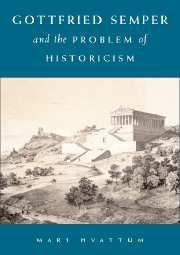Book contents
- Frontmatter
- Contents
- List of Figures
- Prolegomenon
- Introduction – Gottfried Semper: Texts and Interpretations
- PART I TOWARDS A POETICS OF ARCHITECTURE
- PART II PRACTICAL AESTHETICS
- 4 Semper and Practical Aesthetics
- 5 The Comparative Method
- 6 Towards a Method of Inventing
- PART III THE APORIAS OF HISTORICISM
- Epilogue
- Notes
- Selected Semper Bibliography
- Bibliography
- Index
4 - Semper and Practical Aesthetics
from PART II - PRACTICAL AESTHETICS
Published online by Cambridge University Press: 06 August 2009
- Frontmatter
- Contents
- List of Figures
- Prolegomenon
- Introduction – Gottfried Semper: Texts and Interpretations
- PART I TOWARDS A POETICS OF ARCHITECTURE
- PART II PRACTICAL AESTHETICS
- 4 Semper and Practical Aesthetics
- 5 The Comparative Method
- 6 Towards a Method of Inventing
- PART III THE APORIAS OF HISTORICISM
- Epilogue
- Notes
- Selected Semper Bibliography
- Bibliography
- Index
Summary
Semper's sensitive recognition of the social and symbolic significance of architecture made the shortcomings of contemporary architectural discourse and practice all the more obvious to him. “Notwithstanding our many technical advances, we remain far behind them (our ancestors) in formal beauty, and even in the feeling for the suitable and the appropriate”, he wrote, a complaint frequently repeated throughout his work. Yet, the state of decay in the arts was not merely the fault of the artists. Semper saw the ‘Babel-like confusion’ confronting him at the Great Exhibition of 1851 as “nothing more than the clear manifestation of certain anomalies within existing social conditions, whose causes and effects up to now could not be seen by the world so generally and so distinctly.” Semper conceived the question of style not simply as an aesthetic problem, but also as a political, ethical, and philosophical issue with critical implications for contemporary society.
The second step of Semper's theoretical project was intended to address this critical state of affairs. He alleged that to counter the contemporary crisis, it was necessary to systematise architectural design into a “logical method of inventing”. Opposed to the “characterless schematism and thoughtless caprice” of the architecture of his day, Semper's method was to teach how to “make artistic use of our social needs as factors in the style of our architecture in the same way as has been done in the past.” This procedure would contribute towards
getting a clear insight over [art and architecture's] whole province and perhaps also it would form the base of a doctrine of Style, and a sort of topic or Method, how to invent, which may guide us to find a more natural way of invention.
- Type
- Chapter
- Information
- Gottfried Semper and the Problem of Historicism , pp. 87 - 113Publisher: Cambridge University PressPrint publication year: 2004



